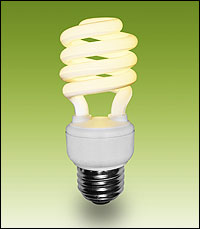You might be surprised to hear it (since I am both a geek who leaves his computer on 24/7, and an energy-wasting American, if you believe the stereotype), but I do try to conserve energy and resources wherever I can. I’ve never owned a gas-guzzling car (all 4 bangers, even the truck and SUV), and I try to recycle where I can. However, back where I used to live (in the lovely city of Fitchburg) it was a little hard to stick to my ideals. Specifically, I’m talking about home energy savings – lights and heat.
Heat was a hard nut to crack, because the house I lived in was very, very old. Old houses are drafty (unless you spend lots of money to fix them up), and let’s not even talk about the crusty windows I was stuck with. The ancient gas-fired heater wasn’t especially efficient, either – there was only the one unit, in the kitchen, and there was no way to spread the heat to other rooms other than by turning it up and letting it run longer. And the electrical outlets were so old that you couldn’t put a compact fluorescent bulb in anywhere – they’d blow out because of the shoddy wiring. And my place was pretty dark, being at the back of the house. Needless to say, my gas & electric bills were quite high.
But I don’t live there anymore! Now I live in a nice new place, with modern, up-to-date wiring and insulation and windows – windows that even have storm windows for extra insulation!
So one of the first things I did when I moved in here was to replace almost every single light with a compact fluorescent bulb.

Having used them for a bit now, I can say I’m a big, big fan. A 60-watt equivalent compact fluorescent bulb (CFB) uses something like 14 actual watts of electricity. Sweet! I can have all the lights on in the house, and be using almost the same amount of energy I would’ve used for just ONE light back in Fitchburg! (And of course I hardly ever have ALL the lights on at the same time.)
If you haven’t tried CFBs, I highly recommend giving them a try. They cost a little more up front, but they more than make it up in the long run. I will probably end up taking these bulbs with me when we buy a house someday – that’s how long they’ll last.
The only downside to them is that if you have a lot of CFBs all on one switch (such as a row of lights above the bathroom sink, for example), they can take a minute or two to get up to full brightness if they haven’t been on recently. And if you turn the lights on & off frequently, you won’t get the best efficiency out of them – so you may still keep an old-fashioned bulb around for those sorts of things. (I kept the old bulbs in the garage, because we’ll often turn the lights on in there for just a minute or two – and on the porch, because that bulb is yellow to keep from attracting insects.)
I don’t have anything to say about the nice insulation in this place yet – it hasn’t gotten cold enough to turn on the heat yet. But insulation is nothing new – CFBs, although not technically new, are still not used nearly as much as they could be. You still sometimes see ads saying that if every American household replaced just one light bulb with a CFB, we would save millions of tons of carbon from going into the atmosphere or something like that. And it’s very true, these bulbs are very energy efficient – the savings on your electric bill are well worth it – but my point is that not everyone can use these bulbs, even if they want to. Like I said before, in my old place, I would’ve loved to use them – and even did try to use them – but the old outlets and light fixtures just blew them out after a few cycles. And when you’ve got a $4-$8 bulb, having it blow out every few days is not a good investment!
So, I guess what I’m trying to say is, if you can, give CFBs a try. If your house doesn’t reject them (as mine did), I think you’ll be pleased. And if lots of people try them, and use them, we’ll all be a lot happier, I think.